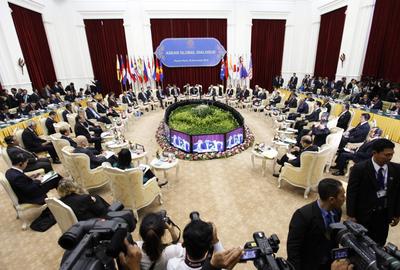The ‘Phnom Penh milestone’ signalled ASEAN’s determination to lead the way in assembling the emerging regional economic architecture. The existing FTAs between ASEAN and China, Japan, South Korea, India, Australia and New Zealand could eventually lead to the creation of an integrated market with a combined market population of more than three billion people, and a combined GDP of about US$19.78 trillion (based on 2011 figures). With the region accounting for more than half of the global market and about a third of global economic output, a successful RCEP would significantly boost global trade and investment.
RCEP is a strategy aimed at maintaining regional growth by ensuring the markets of participating countries remain open and competitive. At the same time, the official launching of RCEP has strengthened ASEAN centrality in regional economic integration as the United States-led Trans-Pacific Partnership gradually progresses toward its scheduled conclusion at the end of 2013.
Considering the existence of multi-track sub-regional and bilateral FTAs in the region, the RCEP negotiations will likely be tedious and complex. The 16 leaders have attempted to overcome this challenge by endorsing RCEP’s Guiding Principles and Objectives for Negotiating, a document that leaves open the possibility of other regional economic partners eventually being drawn into the agreement. To conclude the RCEP negotiations by 2015 will not be an easy task given the agreement’s objective to attain a comprehensive, high-quality and mutually beneficial economic partnership agreement that involves deeper engagement than existing ASEAN FTAs. The question then stands: how to move forward?
The negotiation process could be facilitated by identifying the major characteristics of existing ASEAN agreements with its six regional trade partners. Negotiations should be built on existing ASEAN+1 FTAs because starting from scratch would be too complex, but the process should eventually require the integration and liberalisation of all ASEAN FTAs. On trade in goods, for example, ASEAN+6 countries use different tariff classifications for their tariff concessions, making it difficult to construct rather straightforward schedules. It is not only that different countries use different tariff schedules, but the same countries also use different schedules for their FTAs with different countries. In addition, tariff concessions from the same country differ depending on FTAs, and tariff elimination rates are different across ASEAN+1 FTAs. A common concession approach on certain goods should therefore be considered.
Rules of origin (ROOs) will play an important role in ensuring that preferential treatment is accorded to FTA members by avoiding trade deflection, and hence the ROOs will increase FTA utilisation. RCEP should pursue a simplified approach to ROOs, involving harmonisation, co-equality of rules and the cumulation of value contents that aim to lower transaction and time costs.
Agreements on trade in services and investment have not been included in all ASEAN+1 FTAs. Agreements on service trade are included in the ASEAN–Australia/New Zealand, ASEAN–China and ASEAN–South Korea FTAs but not in the ASEAN–Japan or ASEAN–India FTAs. Similarities do exist in the level of liberalisation commitments among ASEAN+1 FTAs and the ASEAN Framework Agreement on Services (AFAS), which indicates that the sectoral patterns of liberalisation processes for trade in services under ASEAN+1 FTAs are similar and thus consolidating these FTAs into one may be possible. In order for ASEAN and its trade partners to gain substantial new commitments that are genuinely ‘WTO Plus’, ASEAN++ countries should aim for much higher standards than those offered under AFAS’ fifth package of commitments.
Given the ASEAN Economic Community (AEC) Blueprint focuses on the ‘priority sectors’ of air transport, e-ASEAN, healthcare, tourism and logistics services, within the mandate of retaining ASEAN centrality, concrete steps toward liberalisation and harmonising AFAS and ASEAN+1 FTAs should be formulated at the earliest opportunity. In addition to the priority sectors, transportation, distribution, telecommunications and financial services should also be the focus of policy attention, as there is an urgent need to prioritise production-related service sectors in the RCEP negotiations.
An agreement on investment is included in the ASEAN–China, ASEAN–South Korea and ASEAN–Australia/New Zealand FTAs, but a comparison reveals several differences with respect to national treatment, performance requirements and market access. RCEP’s Guiding Principles and Objectives for Negotiating will aim to create a liberal and competitive investment environment in the region, and negotiations for investment will cover the four pillars of promotion, protection, facilitation and liberalisation.
The progress and conclusion of RCEP negotiations are dependent on the timely conclusion of the AEC Blueprint, which is scheduled to be completed in 2015. The implementation of the Blueprint, in turn, is dependent on domestic reforms and behind-the-border measures, such as regulatory governance and coherence, competition policy, intellectual property rights and coordination between negotiating and implementing agencies in ASEAN countries. Building up cohesive and strong domestic constituencies in ASEAN+6 countries is critically important to providing domestic policy support for the timely conclusion of RCEP negotiations. In this context, the involvement and active participation of the private sector is critically required.
The way forward for RCEP negotiations should be based on rationalisation and flexibility in consolidating the existing ASEAN+1 FTAs to maximise benefits and lower costs of doing business. In enhancing market access, due consideration should be given to the different stages of economic development across the region through special and differential treatment. There should be an emphasis on providing time extensions rather than lowering the threshold level for negotiations.
Hank Lim is Senior Research Fellow at the Singapore Institute of International Affairs.


RT @east_asia_forum: The way forward for RCEP negotiations by Hank Lim http://t.co/J3cXXbYz